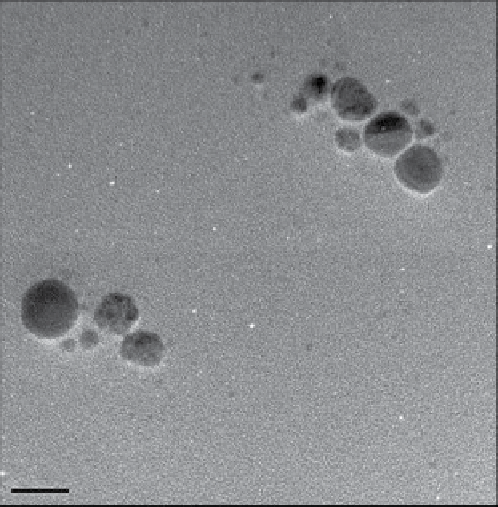Environmental Engineering Reference
In-Depth Information
20 nm
FiGurE 19.1
Biologically synthesized silver nanoparticles (NPs) using
B. flexus
GS5.
their cytoplasm. Nevertheless, the metal aggregates were found only in those organisms that were capable of withstanding
concentrated heavy metals. These were termed as competent organisms; they possessed the ability to bind with metal ions
forming aggregates. This phenomenon was observed in both Gram-positive and Gram-negative bacteria [12-14]. However,
the metal aggregates were not identified as NPs at that time [13]. Gram-positive bacteria like
Bacillus subtilis
showed
higher adsorption capacity for various metals than Gram-negative bacteria like
Escherichia coli
[14]. The biological syn-
thesis of silver NPs came into the limelight in 1984 when Haefeli and his colleagues first reported synthesis of silver NPs
from a silver mine bacterial strain
Pseudomonas stutzeri
AG259 [15-17]. Several
Bacillus
species also have been reported
for the synthesis of silver NPs. We found that
Bacillus flexus
GS, a novel isolate from silver mines, produces silver NPs
(Fig. 19.1).
19.3
Why microbiAl SynthESiS?
Recently biogenesis of silver NPs has gained attention because of its green approach. A lot more physical and chemical
methods are also available for the synthesis of silver NPs. Physical methods like spark discharge, pyrolysis, and attrition are
available for NP synthesis. The chemical methods involve reduction of metal ions into NPs and prevention of their aggregation.
A lot more reducing agents are available, including sodium borohydride, methoxypolyethylene glycol, potassium bitartarate,
and hydrazine [2, 18, 19, 20]. Stabilizers are used to prevent the aggregation of NPs. Some of the stabilizers are sodium dodecyl
benzyl sulfate and poly vinyl pyridone [19, 20].
Physical and chemical methods are subject to some drawbacks. High yield is not possible in the physical method, and the
chemical method involves usage of toxic solvents like thioglycerol and 2-mercaptoethanol and the production of hazardous
by-products [2]. Since silver NPs are used for medical purposes, the toxic components that are involved in their synthesis cause
problems. It was found that chemically synthesized NPs have chemicals over their surfaces [21]. This limits the application of
silver NPs in the medical field.
In order to overcome the problems faced in physical and chemical methods, biosynthesis of NPs came into focus, since
there is no usage of toxic chemicals and the scaling-up process is affordable. Moreover, the method is green, and it uses only
biological components for NP synthesis. It is simple and less time-consuming when compared with other techniques. Hence,
NPs can be produced at lower costs with reduced toxicity [22]. There is no need for any stabilizers as that in chemical
methods because the proteins in the microorganisms act as stabilizers [23]. The biological approach adds to further extensions

